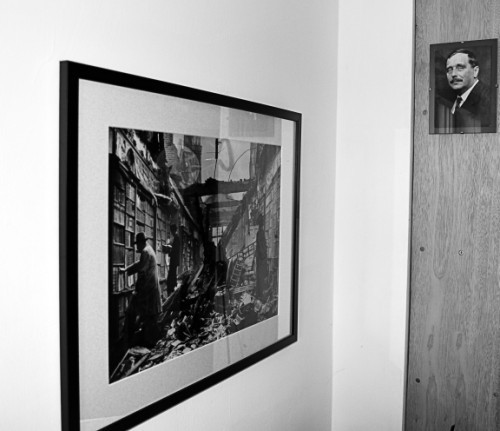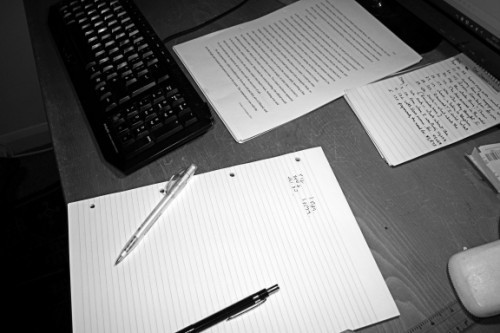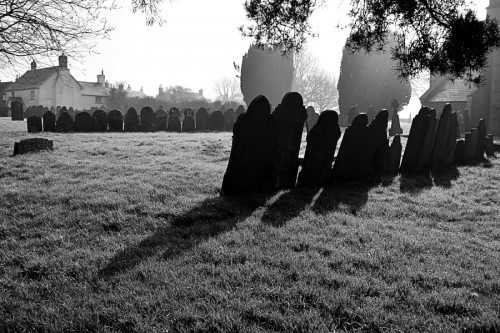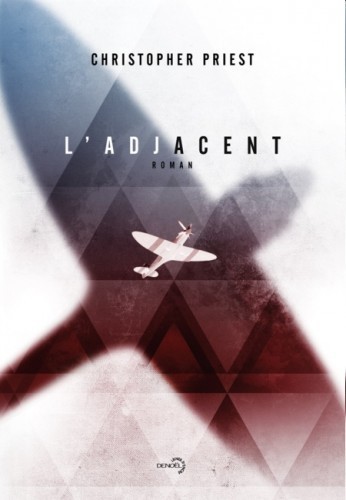Christopher Priest's Blog, page 10
May 8, 2015
Here and Now
April 29, 2015
Head down
We are at the end of April and I suddenly realized that I have posted nothing here since the end of March. The Devon countryside is waking up as the days lengthen: during the winter months it is bleak of colour, the hedgerows bare, the muddy soil showing through. It still looks beautiful and peaceful, and the roads are quiet and under-used, but winter is winter. Here in the southwest that mostly means rain and wind. I  can confirm that’s true. But for the last four weeks the narrow roads have been a blaze of colour. The modest, familiar British wildflowers have returned. At the moment we have sweet alison, red campion, bluebells, and the first flush of cow parsley is looming over the lanes. I have had nothing to say here as I am deep into the final draft of my next novel, a period when what I’m doing spreads out psychically to blot out other matters. Thankfully, because out there in the world there is an election campaign going on, terrible disasters in the French Alps and the southern Mediterranean and Nepal, and an attempt by a small group of bigots in America to take over the Hugo awards. The bathetic nature of the final part of that sentence is sort of accidental, but it reveals what a narrow world of desperation some third-rate writers live in. I hope to complete my novel during the next two months.
can confirm that’s true. But for the last four weeks the narrow roads have been a blaze of colour. The modest, familiar British wildflowers have returned. At the moment we have sweet alison, red campion, bluebells, and the first flush of cow parsley is looming over the lanes. I have had nothing to say here as I am deep into the final draft of my next novel, a period when what I’m doing spreads out psychically to blot out other matters. Thankfully, because out there in the world there is an election campaign going on, terrible disasters in the French Alps and the southern Mediterranean and Nepal, and an attempt by a small group of bigots in America to take over the Hugo awards. The bathetic nature of the final part of that sentence is sort of accidental, but it reveals what a narrow world of desperation some third-rate writers live in. I hope to complete my novel during the next two months.
March 20, 2015
Light
It’s the first day of Spring, according to Google, with an eclipse of the sun thrown in to celebrate the new awakening. According to the weather news on the radio there were not likely to be many places in the UK without cloud cover, but the west country was excepted. On venturing out we discovered that we had a clear blue sky, with a lovely silvery mist lightly shrouding the trees and the countryside.
I spent the hour of the eclipse wandering around our village centre and the huge churchyard, while the light slowly dimmed and the wild birds went into alternating bouts of mad squawking and mystified silence. Our cats took fright. No cars went through. The temperature dropped noticeably. The shadows became less dark as most of the sun disappeared briefly behind the moon. That weird quietude of an eclipse slowly spread across the countryside.
Afterwards I discovered what perhaps I should have known anyway, which is that it’s almost impossible to photograph an eclipse without special lens filters. All my efforts to capture the ever-reducing arc of remaining sunlight came to nothing. However, the light in the trees and across the graveyard was something I will never forget.
March 12, 2015
Terry Pratchett
My obit of Terry in the Guardian is here. I knew Terry for more than half a century: we met in 1964 at a convention in Peterborough. He was still at school – I was the world’s worst trainee accountant. We both moved on a bit afterwards. I believe his conduct as a successful author was and is exemplary. The quality of his writing never failed. I would say more, but it is already in my Guardian piece.
February 18, 2015
“Open Your Balls”
I went to see the new film Mortdecai (2015) with a feeling of duty to an old friend. (Kyril Bonfiglioli, who wrote the novels.) The reviews of the film have been almost universally awful, and after Nina and I saw the trailer last week I couldn’t help thinking it was going to be something to get through and keep quiet about afterwards.
Bon was such a great and long-lasting friend. He bought, published and even paid for my first story (eight guineas!), but that was not the sole basis for a friendship that lasted twenty years. In the mid 1970s he began writing the Charlie Mortdecai novels, completing three of them before the dread consequences of the demon booze caught up with him in 1985. He also wrote a non-Mortdecai novel, All the Tea in China (1978). After his death, an unfinished fourth Mortdecai novel was found in his papers – this was completed a few years later by Craig Brown.
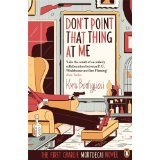

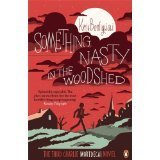
The Mortdecai books have recently been reprinted by Penguin Books. I read them as they came out in the 1970s – they struck me then as fabulous: fast-moving, extremely intelligent, funny, self-awarely xenophobic, ingeniously nasty, and full of bits you want to read out aloud to others. At the beginning of the first book (Don’t Point That Thing at Me) he wrote: “This is not an autobiographical novel: it is about some other portly, dissolute, immoral and middle-aged art dealer.” I would recommend the books without qualification if it were not for the fact they are now more than 30 years old, and the way we perceive world has changed a bit since then. Well, all right: give them a go!
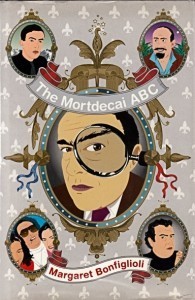 There is also a book called The Mortdecai ABC, by Margaret Bonfiglioli, published by Viking in 2001. This is a wonderful compendium, arranged in a kind of alphabetical order, of everything and a bit more about Bon. There is, for instance, a series of biographical sketches – a few sample headings include Car Crashes, Hidden Jokes, Food, Lies, Parrot, Waistband and Waistline, Tea. All his editorials from Science Fantasy are here, and every short story he ever wrote. Letters to his publishers. And letters to friends: a whole chapter reprints some of the correspondence between Bon and myself in the 1970s. In her Introduction, Margaret (Bon’s ex-wife) writes: “How did I happen to put together this book? Laughter began it.”
There is also a book called The Mortdecai ABC, by Margaret Bonfiglioli, published by Viking in 2001. This is a wonderful compendium, arranged in a kind of alphabetical order, of everything and a bit more about Bon. There is, for instance, a series of biographical sketches – a few sample headings include Car Crashes, Hidden Jokes, Food, Lies, Parrot, Waistband and Waistline, Tea. All his editorials from Science Fantasy are here, and every short story he ever wrote. Letters to his publishers. And letters to friends: a whole chapter reprints some of the correspondence between Bon and myself in the 1970s. In her Introduction, Margaret (Bon’s ex-wife) writes: “How did I happen to put together this book? Laughter began it.”
How sad it was to read the previews and reviews of David Koepp’s film Mortdecai. Peter Bradshaw in The Guardian wrote: “The poster is awful. The premise is awful. To be frank, quite a lot about it is awful: a middle-aged comedy caper of the kind not seen since Peter Sellers’s final outings as Clouseau and Fu Manchu.” Geoffrey Macnab in The Independent said: “an incredibly convoluted script involving a stolen Goya painting, random changes of location (we are whisked, for no particular reason, from London to Moscow to LA), too many gags involving vomit and rotting cheese, and some incredibly dull and dim-witted dialogue that would barely have passed muster in a bad British 1970s sitcom.” Things were no better in the USA, where box office takings were said to be some $50 millions below budget. Josh Slater-Williams in SoundOnSight wrote: “a cataclysmically unfunny, unbelievably tedious disaster of baffling misjudgments and multiple career lows that feels as long as Shoah, and only a little less harrowing.” The end of Johnny Depp’s career was doomily predicted by all and sundry.
Well, we went to see it anyway. I loved it. Nina loved it. We both laughed out loud several times, laughed quietly most of the time, and at very worst were agreeably amused for the rest. The audience enjoyed it too. It has a tremendous pace, scurrilousness, wit, a ridiculous heist, stupid violence, jokes about moustaches and penises and vomit and smelly cheese and foreigners. What more do you want?
Do try to catch the film while it is still around in theatres. And don’t miss the books!
January 6, 2015
Standing on shoulders
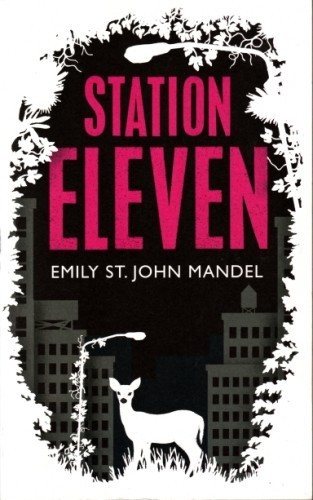 I am late to the party: Station Eleven was published in the UK about four months ago and has won many favourable reviews, it was a best-seller in the USA and was shortlisted for the National Book Award. I suspect more accolades are to come for this remarkable novel. We enjoy books on a personal level, and if we set out to write a favourable review afterwards what we are really doing is trying to express that feeling in objective terms. In other words, we translate enjoyment into admiration.
I am late to the party: Station Eleven was published in the UK about four months ago and has won many favourable reviews, it was a best-seller in the USA and was shortlisted for the National Book Award. I suspect more accolades are to come for this remarkable novel. We enjoy books on a personal level, and if we set out to write a favourable review afterwards what we are really doing is trying to express that feeling in objective terms. In other words, we translate enjoyment into admiration.
But this time, instead of trying for critical distance, let me give a more subjective account of this book. It involves an indirect approach.
In the early 1960s, barely out of adolescence and working unhappily in a London office, I discovered the existence of the National Film Theatre. It showed in repertory the sort of films I had never seen while a child in the bosom of the family: the NFT had foreign films, experimental films, old films, independent films, arthouse films. I joined with alacrity, and soon received their current programme: they were about to start a retrospective season of films by Ingmar Bergman. I sent off for tickets.
During the following two weeks I saw four Bergman films at the NFT: Sawdust and Tinsel, Summer with Monika, Wild Strawberries and The Seventh Seal. All were in black and white; the dialogue, of course, was in Swedish (and delivered in theatrical tones, punctuated with long silences); the subtitles were erratic and shaky; the prints were scratched. The themes were sexuality, impotence, love, humiliation, betrayal, pride, death. It was a transforming experience. Nothing before had ever intrigued or satisfied me so much. A mood of gloom, wonder, excitement and ambition gripped me. Later, I was to see many more Bergman films, but the shocking impact of those first four was never quite to be repeated. For me, ever after, Bergman’s work has been an exemplar, a precedent, a goal.
The first of Bergman’s films that I saw, and therefore the one which had the profoundest effect on me was Sawdust and Tinsel. This is set in a ramshackle travelling circus, the wagons pulled by exhausted horses. The players’ circus costumes are threadbare, their audiences minimal. The mood is defiant, jealous, defensive, mystical.
Much of the action in Emily St. John Mandel’s novel Station Eleven describes a ramshackle group of survivors, travelling in engineless, horsedrawn pick-up trucks, working their way through the remains of the state of Michigan after a global disaster. All the characters are actors or musicians, or people who have learned since the disaster to be actors or musicians. They call themselves the Symphony, and at each of their stops they put on their threadbare costumes and perform. Sometimes they mount King Lear or Hamlet; at other times they play classical music. They also have to hunt, scavenge and kill, but at the end of the day they set out chairs for whatever audience they can attract, the conductor taps her baton on the stand and they start playing a Beethoven symphony.
The concerns and eventual destiny of the characters are different in detail from those of Bergman’s, but the subtlety, complexity, doggedness and despair of Mandel’s characters resonate strongly with his.
Around the same time as my discovery of Ingmar Bergman, I came across a novel well liked in the SF world, although at the time I had no knowledge of that. To me it was just a book I happened to buy. It was Earth Abides, by George R. Stewart. Stewart was an expert in place-names, an historian and a professor of English at Berkeley. He appears to have had no knowledge of or connection with the science fiction genre. Earth Abides was not his only novel, but it was his only purely speculative work.
It describes the collapse of civilization after a global pandemic – at first the central character, Isherwood Williams, believes himself to be the only survivor, by a fluke. Later he discovers one or two other survivors. Human society tentatively begins to re-form.
An aura of loss, death, guilt, failed responsibility hangs over the background to the novel, not unlike in Bergman’s early films. There is a broader outlook, though: Earth Abides is also about the impact humans have had on the physical environment, and there are many scenes depicting the changes to the world that follow the demise of humanity, all of them thrilling and moving to read. Stewart was an ecologist, a green, decades before that awareness had any currency outside the work of a few specialist scientists.
This was powerful stuff for a teenager to read, and it left a lasting impression on me. I still believe that because of this book my consciousness about pollution, climate change, waste of fossil fuels, the dangers as well as the benefits of a technological society, was raised many years before these issues became understood in the general world. I also know that this is not a unique reaction: the book is regarded as a classic by many of the people who came across it half a century ago.
Bergman and Stewart – they are giants in my life. I can offer no higher compliment to Ms Mandel than to say that while reading her novel these potent sensibilities were re-awakened in me. Perhaps a new generation will draw from Station Eleven something of the same understanding of the frailty of life, or of the interconnectedness of the world, or of the wonderful and inspirational gloom that I drew many years ago from these giants. Her novel is complex, subtle, wise, beautifully written, layered, original and often moving. I cannot commend it more highly.
Station Eleven by Emily St. John Mandel, Picador, 2014, ISBN: 978-1-4472-6896-3, £12.99
January 1, 2015
L’Adjacent
Here is the beautiful new cover for the French edition of The Adjacent. The artist is Aurélien Police, and the book will be published in April, by Lunes d’Encre (Denoël). Editor: Gilles Dumay.
I will be in France during May, firstly at Étonnants Voyageurs in St-Malo (23-25 May), then at Imaginales in Épinal (28-31 May).
November 19, 2014
The Stars my Mutteration
This is a public service entry:
Oh, my God. / Cooper, there’s no point using our fuel to – / Just analyse the Endurance’s spin – / What’re you doing?! / Docking. / Endurance rotation is 67, 68 RPM – / Get ready to match it on the retro-thrusters – / It’s not possible – / No. It’s necessary.
When I wrote the blog entry immediately below this one I had been planning to write a review of Christopher Nolan’s new film, Interstellar, which I saw at the end of last week. That idea was hijacked by the sudden arrival of my copies of the Gollancz edition of A Dream of Wessex. Because I was thinking about Nolan I remembered I had always wanted to write about the similarities between that novel and his earlier film, Inception. So I did that instead. (See below.)
Interstellar is a problem, a long, poorly written and second-rate film with a wide popular appeal, so I briefly decided enough was enough. Other people, notably Abigail Nussbaum, have elegantly and convincingly demolished it.
But yesterday there were several stories in the press, on the radio and all over the internet about the sound level of the new film. Many audiences have complained that the music and sound effects are too loud in Interstellar, while the dialogue is too low to be heard and followed. There were stories of people demanding their money back, and a theatre in Rochester NY putting up a sign saying that their sound equipment was not at fault: the film’s soundtrack had been recorded that way. Christopher Nolan himself came forward to confirm this, calling it ‘a carefully considered creative decision’, using the dialogue as a sound effect, to ‘emphasize how loud the surrounding noise is’.
The composer, Hans Zimmer (a highly regarded film composer, and rightly so), is himself totally unapologetic, and says so here. But as writer and director of the film, and someone who presumably oversaw the editing and sound mixing, Christopher Nolan has the greater responsibility.
Anyone knows the reality. The ‘surrounding noise’ of space is silent. Space is a vacuum – it is incapable of carrying sound. How Hans Zimmer’s loud music can be heard in space is a mystery only Nolan can explain.
(An earlier Nolan film, his adaptation of my novel The Prestige, had similar problems with music and dialogue recording. Although overall I admired the film, I have always been concerned with these two crucial weaknesses. Until Nolan came forward today to explain his creative decision, I had assumed the muttered dialogue was a mistake, a consequence of inexperience.)
Returning to Interstellar: By chance I am one of the few people who had no problem with the dialogue of this extremely long film. The version we saw was subtitled ‘for the hard of hearing’, so every word of the script was plain. I can therefore report that much of the dialogue creatively hidden from the audience is similar to the short extract above, and the rest is … not exactly Shakespearean pentameters.
Nolan clearly uses dialogue as a sort of fill-in noise. He calls it a sound effect. For him, words are something he has to get the actors to come out with while they’re performing set-pieces or going through spectacular scenes.
This was particularly true of Inception, which had one of the worst-written scripts I have come across. I winced at its clumsiness several times while watching it – a later look at the shooting script confirmed the clodhopper style was not my imagination. (Christopher Nolan was credited as writer.) Interstellar came from a different source: it was originally written solo by Jonah Nolan for a planned film by Steven Spielberg – that original script was very different from the finished film. Jonah’s original can be read on the internet, where there are several discussion pages about the many differences between the two. As Christopher Nolan is credited as co-author of the final screenplay, we assume that he was responsible for the changes when he took over the project from Spielberg. He has said so himself.
Dialogue is crucial to film: the words given to actors to deliver humanize the story, make it comprehensible to the audience, create characters with whom we can sympathize or at least understand. Nolan’s argument that dialogue is just another sound effect is weak and unconvincing, and is of course an evasion of something much more serious. If the dialogue he has written consists of people mumbling to themselves, or shouting about retro-thrusters over the noise in space, then maybe he is writing the wrong kind of dialogue in the wrong kind of film.
November 18, 2014
A Dream of Inception
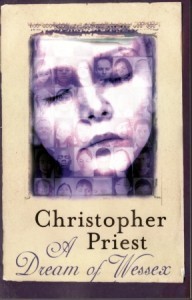 Here is the Gollancz paperback of A Dream of Wessex, just released. The novel has been unavailable for several years, so I’m pleased to see it in this attractive stripe. For those who are interested in such things, it was first published as a Faber hardcover in the UK in 1977, which makes it getting on for forty years old. I imagine some aspects of it will now seem dated, but maybe that’s how it should be.
Here is the Gollancz paperback of A Dream of Wessex, just released. The novel has been unavailable for several years, so I’m pleased to see it in this attractive stripe. For those who are interested in such things, it was first published as a Faber hardcover in the UK in 1977, which makes it getting on for forty years old. I imagine some aspects of it will now seem dated, but maybe that’s how it should be.
Wessex is not so dated, though, that some people were prevented from pointing out the similarities between this book and Christopher Nolan’s film Inception, released in 2010, a mere thirty-three years later. Both deal with the exploration of the dream state, and how that impinges on reality, or our perception of reality. I say straight away that I did not notice anything more than minor coincidences myself, and never mentioned the few bits I registered. Anyway I would be reluctant to make what might seem an allegation that Christopher Nolan had nicked some of my material. He and I have a known professional relationship, and I assume he is familiar with most of my books, even if he hasn’t read them closely.
The first time someone pointed out the several resemblances between the two I was surprised that I had missed so many of them, but after more people had gently explained them to me I began to see.
Like many people who went to the film, I had been dazzled by its surface, the astonishing CGI effects and photographic trickery. I found the plot more or less incomprehensible, though – it was a kind of mix of James Bond antics (buildings collapsing, explosions, chases, guns, snowmobiles), and men in business suits mouthing lines about reality and dreams, and finishing each other’s explanatory sentences. I gave up trying to follow the plot after this pungent exchange:
So how did we end up at this restaurant? / We came here from … / How did we get here? Where are we? / Oh my God. We’re dreaming. / Stay calm. We’re actually asleep in the workshop. (Pp. 66 – 67 of the shooting script, published by Insight Editions.)
The urge to describe and explain the plot through dialogue is incidentally a similar feature of Nolan’s current release, Interstellar. In this three-hour spaceship adventure there are extended dialogues between astronauts in spacesuits, risibly explaining orbits, trajectories, relativity and wormholes to each other, finishing each other’s explanatory sentences, and drawing primary-school level graphics to convince themselves the plot is going OK. This was so nakedly aimed at the assumed ignorance of the audience that it was embarrassing. As soon as a film engages in trying to meet the imagined comprehension of an audience, it loses itself. Consider instead the success of Jonathan Glazer’s Under the Skin (2013), which showed everything and explained nothing.
But back to Inception. Some of it was genuinely beautiful and mysterious to watch: the city of Paris inverting, trick mirrors along the banks of the Seine, a super-slo-mo shot of a van plunging into an icy river from a bridge, a ruined city slowly collapsing into the sea. These are all Nolan’s creation, or that of the CGI studios who developed the images for him.
Some of it, I saw belatedly, did have an uncanny likeness to my novel. There is, for instance a scene below ground, in fact in the basement of Yusuf’s pharmacy, in which a large number of people are shown to be sharing a continuous dream, one from which it is impossible or dangerous to withdraw. This might be part of a dream within a dream! The situation exactly matches the MacGuffin in A Dream of Wessex, which is about a scientific experiment in which a large number of people go below ground, and create a pooled dreamworld, one which is so plausible that it becomes hard for them to distinguish it from reality. Withdrawal from it is difficult and dangerous. And both film and book deal with the risks attached to creating a second or third level of dream, within the dream.
I’m nearly forty years away from the writing of A Dream of Wessex, and looking at it now I find it has some surprises for me. I make no claim for it. It is what it is, and in my own writing chronology it was a tentative first step towards the material in The Affirmation, which followed it. Wessex is a sort of transition from what I wrote in the early days, to the fiction I wrote later. (Some people, not I, might argue this was a progress from futuristic or ‘science’ fiction to a more sophisticated ‘speculative’ fiction, which is, interestingly, the exact distinction Christopher Nolan makes in the Introduction to the screenplay of Interstellar, also published by Faber. His film about astronauts and spaceships and alien planets is, he says, speculative fiction not science fiction. It lacks futurism, he claims, and is true to the contemporary world.)
But I’ll say this of Wessex: it has the quality of a direct narrative, where the plot is revealed through the characters: their actions, their relationships, their discoveries. They don’t sit around discussing the plot, and helping each other explain complicated ideas – they get on with the story. Maybe that’s how we did it in the old days …
A Dream of Wessex: Gollancz, 2014, 240 pp, £8.99, ISBN: 978-0-575-12153-9
Inception – the Shooting Script: Insight, 2010, 240 pp, £10.99, ISBN: 978-1-608-87015-8
Interstellar – the Complete Screenplay: Faber, 2014, 380 pp, £20.00, ISBN: 978-0-571-31439-3
November 5, 2014
A New Affirmation
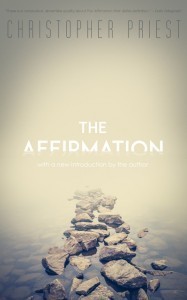 Here is the cover image of a brand-new US paperback of my 1981 novel, The Affirmation. This is scheduled to be published in January 2015 by the superb American indie publisher Valancourt, with a new introduction written by myself.
Here is the cover image of a brand-new US paperback of my 1981 novel, The Affirmation. This is scheduled to be published in January 2015 by the superb American indie publisher Valancourt, with a new introduction written by myself.
The Affirmation has been effectively unobtainable in the USA almost from the moment it was published in hardcover by Scribner. Their edition lacked a certain feeling of conviction and the book received mediocre reviews. I have memories of coming across three rather battered copies a few weeks after publication, on sale in a branch of Crown Books in Houston — they looked sad and unloved, and I was tempted to buy them myself to put them out of their misery. A year later, when I was back in Houston, I found the same three copies still on sale in Crown Books, but now they were priced at 5¢ each and still had no buyers. It is moments like that which remind writers of their lowly place in the universe. The Affirmation has never had a paperback edition in America until now.
It is not the best-known of my novels, but it has always had a remarkable effect on a significant number of readers. Although it was written in what now seems a distant part of my life, I still regard it as my ‘key’ novel. I go into this in more detail in the introduction.
An odd footnote: Nielsen’s Bookdata no longer lists the Scribner edition of The Affirmation, but a search in the database for the ISBN (which without fear of contradiction or error I can state is 0-684-16957-6) reveals a book called The Affirmation by one Oliver Trager. I generously assume this is not copyright theft, but what Martin Rowson the cartoonist calls (and sometimes draws) a fur cup. I assure Nielsen’s and Mr Trager that I really am the true author of the book, and I have numerous different editions to prove it. I hope that enough readers in the US will now discover the book for themselves.
Valancourt’s interesting website may be viewed here. And an essay I wrote about three years ago, concerning the maddening reviews The Affirmation received, can be found on this website.
Christopher Priest's Blog
- Christopher Priest's profile
- 1073 followers





